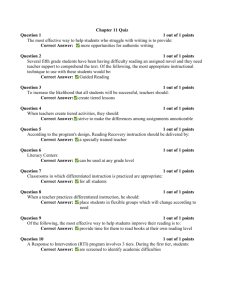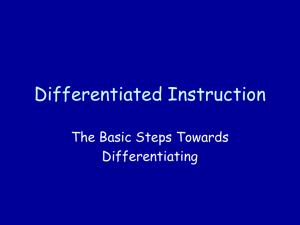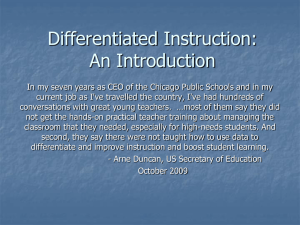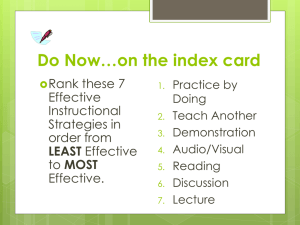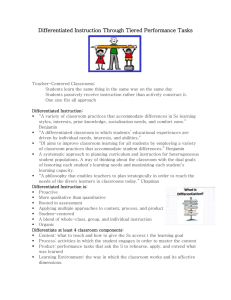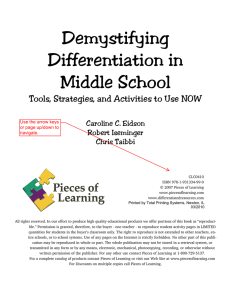differentiated instruction
advertisement
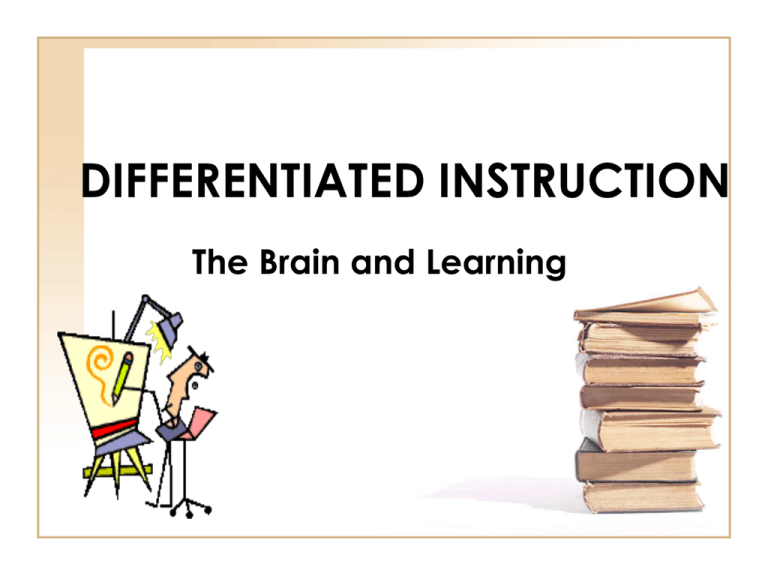
DIFFERENTIATED INSTRUCTION The Brain and Learning Today’s Classroom • 32 students – – – – 2 Attention Deficit 4 have IEPs 2 ESL 4 Unidentified special needs • Total of 38% Brain-Based Learning • Definition: Involves using approaches to schooling that rely on recent brain research to support and develop improved teaching strategies. • Researchers believe that the brain is constantly searching for meaning and seeking patterns and connections. The Brain and Learning Quiz: Question #1 • Correct answer is #2. – Our brains are designed to ensure survival. – Brains can only fully attend to one thing at a time. – Because our brains are built to act first and ask questions later, our attention will immediately go to any unusual, unexpected, or potentially threatening event. – Strong emotion takes over! Strong emotional links create strong learning. The Brain and Learning Quiz: Question #2 • Correct answer is #1. – The brain functions as a whole at all times – The brain is a system and as with any system all of its many parts must be functioning all of the time to be optimally effective. – HOWEVER, these many parts won’t necessarily all function at the same level all of the time! The Brain and Learning Quiz: Question #3 • Correct answer is #4. – Study: 124 subjects divided equally into exercisers and nonexercisers found that those who exercised 75 minutes a week demonstrated quicker reactions, thought better, and remembered more! – Stress releases the chemicals that kill neurons in the hippocampus, the area of the brain that’s responsible for memory formation. The Brain and Learning Quiz: Question #4 • Correct answer is #3. – Our brains are NOT like a computer! There is no limit to what we can learn and your brain never stops processing and storing information. – You may be tired and that does affect how efficient your brain will be. – As we learn new information, our brains form associations which can help us retrieve specific information. The Brain and Learning Quiz: Question #5 • Correct answer is #3. – Primary emotions – universally shared by all people: joy, fear, surprise, disgust, anger, sadness – Secondary emotions – learned behaviors that develop as a result of cultural and environmental circumstances: confidence, worry, anticipation, frustration, cynicism, and optimism Brain Development • Developmental problems • Nutrition (iron deficiencies) • Learning disabilities (right side of the brain is larger/most academic learning is associated with the left side of the brain • ADD, ADHD, and LD students produce a low amount of Beta brain waves (focused attention) • There are structural and functional differences in the brain of children that are dyslexic Use Brain Research in the Classroom • Emotion increases retention • Keep challenge high and threat low • Laugh and learn • Give students a chance to stand and move • Involve multi-sensory approaches • Use graphic organizers to form patterns • Use metaphors • Pay attention to lighting • Utilize the primary-recency effect • Use guided practice LEARNING STYLES • Different people learn in different ways • Take a TEST! The Four Modalities Auditory Strength • Students who have an auditory strength or preference like the teacher to provide verbal instructions. They find it easy to learn by listening. They enjoy dialogues, discussions, and plays. They often remember names but forget faces. They often do well working out solutions or problems by talking them out. They are easily distracted by noise and often need to work where it is relatively quiet. Students often do best using recorded books. ……………………………….. • Students who are not auditory often sit in a lecture and do not really know much of what is being said. They find it difficult to concentrate or listen for long periods of lecture. They will often tune out what is being said or find it hard to stay with the speaker or lecturer. Visual Strength • Students who have a visual strength or preference like the teacher to provide demonstrations. They find it easy to learn through descriptions. They often use lists to keep up and to organize thoughts. They often recognize words by sight. They often remember faces but forget names. They often have well developed imaginations. They are easily distracted by movement or action in the classroom. They tend to be unaware of noise. ………………………………… • Students who are not visual often read a page and then realize they don't know what they have read. They then must reread the page. They find it difficult to concentrate on reading assignments or overhead notes. Kinesthetic Strength • Students who have a kinesthetic strength or preference often do best when they are involved or active. These students often have high energy levels. They think and learn best while moving. They often loose much of what is said during lecture and have problems concentrating when asked to sit and read. These students prefer to do rather than watch or listen. ………………………………… • Students who are not kinesthetic rarely get involved in action oriented activities. They would rather drive than walk. They would prefer not to participate and to watch. Tactile Strength • Students who have a tactile strength or preference often do best when they take notes either during a lecture or when reading something new or difficult . They often like to draw or doodle to remember. They do well with hands-on such as projects, demonstrations, or labs. ………………………………….. • Students who are not tactile rarely take notes or if they do take notes, it is only for things that cannot be remembered easily such as numerical data. They often do not do well with hands-on and find it hard to concentrate during lab activities. Success for All • We are all trying to move education from the "select and sort" model to the "success for all" model. In order to select and sort, intelligence is first measured, and then distributed on a bell curve. • If we are to move from the "select and sort" model to the "success for all" model, we must understand that intelligence comes in many forms. Gardner’s 8 Intelligences • Multiple Intelligences are eight different ways to demonstrate intellectual ability. • Dr. Gardner says that our schools and culture focus most of their attention on linguistic and logical-mathematical intelligence. • We should also place equal attention on individuals who show gifts in the other intelligences • It suggests that teachers be trained to present their lessons in a wide variety of ways using music, cooperative learning, art activities, role play, multimedia, field trips, inner reflection, • and much more. A new way………………….. • Research has led many educators to develop new approaches that might better meet the needs of the range of learners in their classrooms. • One size fits all instruction is NOT a good fit for many learners in an academically diverse classroom Differentiated Instruction What is it? The new “IN” thing or is it? • Over a half century ago, Dr. Virgil Ward, coined the phrase "differential education" to describe his ideas about providing appropriate education for gifted and talented students. • He suggested, essentially, that we could best maximize student growth by beginning our work with children based on where they were (what they knew and how they best learned), and helping them to progress from there. Differentiation is based on 3 beliefs: • Everyone learns differently • Quality is more important than quantity (e.g. significance trumps coverage) • “One-size-fits-all" curriculum and instruction presumes that content is more important than students Differentiated Instruction Means…. • Maintaining a commitment to curriculum standards • Increasing the variety in teaching, learning, and assessment in order to reach more students • Providing high levels of challenge and active engagement in rigorous, relevant learning ……………………………………. • Recognizing that students do not all need to do the same work in the same way • Designing differentiated (tiered) assignments to better respond to students’ specific learning needs ……………………………………. • Using flexible instructional grouping to provide opportunities for students to learn with others who have similar needs • Creating fair and equitable processes for evaluating student learning and assigning grades Differentiated Instruction Does Not Mean ……………………. • Individualization. It is not a different lesson for each student each day. • Giving all students the same work or even identical assessments all of the time. • Assuming that all students learn by listening. …………………………………….. • Merely having centers in the classroom. • Assigning more work to students who have demonstrated mastery in an area. • Only for students who demonstrate a need for acceleration. Beginning >>>>>>>>>>>>>> • For the teacher who is beginning to differentiate learning in the classroom, differentiation may begin by varying the content, processes, or product for each group in the class. • As the teacher becomes more proficient using these techniques, differentiation can occur at all 3 stages of the process for some students. Teachers must ask 3 questions: 1. In the content you must teach, what is it that you want all of your students to know? Content 2. How can each student best learn this in ways that are appropriate to his/her specific needs? Process 3. How can each student most effectively demonstrate what s/he has learned? Product Three (3) Ways to Differentiate Instruction: 1. Differentiating the Content/Topic 2. Differentiating the Process/Activities 3. Differentiating the Product 1. Differentiating the Content/Topic • Readiness – Provide texts at varied reading levels – Reteach – Provide audiotaped materials – Provide key vocabulary lists • Interests – Use examples and illustrations based on student interests • Learning Profile – Present in visual, auditory, and kinesthetic modes 2. Differentiating the Process/Activities • Varying learning activities or strategies to provide appropriate methods for students to make sense of the content • Assignments must be tiered to take into account different ways to meet the same goal. 3. Differentiating the Product • A variety of means students can use to demonstrate what they have learned (See Product Choices Chart in handouts) ASSESSMENT • Differentiation is rooted solidly in two of the major components of assessment ----- those that come at the beginning of learning and continue throughout the process rather than the one that comes at the end and is incarnated in "the test." Placement Assessment • Placement assessment, a strategy which should occur before the onset of instruction. Assessment for placement is a tool that increases the probability that instruction can be made suitable for every student Formative Assessment • Ongoing, formative assessment gives teachers information that they need to create appropriately differentiated work for students. • It provides continuous feedback to teachers and to students • It gives teachers the data they need to monitor and, if necessary, modify both curricular and instructional design. Learning Cycle and Decision Factors Used in Planning and Implementing Differentiated Instruction Strategies for Differentiating • Readiness / Ability • Adjusting Questions • Tiered Assignments • Acceleration/Deceleration • Flexible Grouping • Independent Study Projects • Learning Contracts • Learning Centers • Anchoring Activities Readiness / Ability • Activities for each group are often differentiated by complexity. Students whose understanding is below grade level will work at tasks inherently less complex than those attempted by more advanced students. Those students whose reading level is below grade level will benefit by reading with a buddy or listening to stories/instructions using a tape recorder so that they receive information verbally. Adjusting Questions • During large group discussion activities, teachers direct the higher level questions to the students who can handle them and adjust questions accordingly for student with greater needs. All students are answering important questions that require them to think but the questions are targeted towards the student’s ability or readiness level. Tiered Assignments • Used when the teacher wants all students to focus on the same essential ideas and key skills. • Create an on-level task first then adjust up & down Clone the activity to provide different versions at different levels of difficulty • When tiering, adjust level of complexity, materials, pace, number of steps, etc. Above-Level Task On-Level Task Below-Level Task Learning Contracts • A learning contract is a written agreement between teacher and student that will result in students working independently. The contract helps students to set daily and weekly work goals and develop management skills. It also helps the teacher to keep track of each student’s progress. The actual assignments will vary according to specific student needs. Anchoring Activities • This may be a list of activities that a student can do to at any time when they have completed present assignments or it can be assigned for a short period at the beginning of each class as students organize themselves and prepare for work. • These activities must be worthy of a student’s time and appropriate to their learning needs. “Different” vs. “Differentiated” • Creating activities (ex: learning centers) without directing them to specific students provide things that may be different but it does not constitute differentiation. Using the principles of differentiation, teachers design work that is based on students' needs. EXAMPLE • Students may be grouped by interest but may also have activities set at different levels of complexity (questioning levels/abstract thinking processes) resulting in varying products that employ students' preferred learning modality (auditory, visual or kinesthetic). ............ • Thus the content is being differentiated by interest, the process is being differentiated by readiness (complexity of thinking skills required) and the product is being differentiated by student learning modality preferences. THE END
